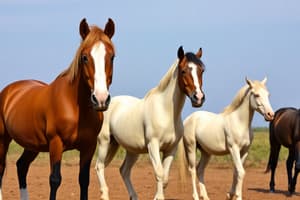Podcast
Questions and Answers
What are the most common sites of impaction associated with colic in horses?
What are the most common sites of impaction associated with colic in horses?
- Transverse colon region and the base of the cecum
- Pelvic flexure region of the left colon and the base and body of the cecum (correct)
- Pelvic flexure region of the left colon and right dorsal colon
- Right dorsal colon and transverse colon regions
What has been speculated as a possible reason for impaction of the cecum in affected horses?
What has been speculated as a possible reason for impaction of the cecum in affected horses?
- Infection with tapeworm Anoplocephala perfoliata
- Diseased or poorly managed teeth
- Insufficient water intake
- Abnormal cecal muscular activity (correct)
Which breeds were overrepresented among horses with cecal impaction according to a clinical study mentioned in the text?
Which breeds were overrepresented among horses with cecal impaction according to a clinical study mentioned in the text?
- Mustang, Friesian, and Andalusian
- Thoroughbred, Quarter Horse, and Warmblood
- Morgan, Arabian, and Appaloosa (correct)
- Pony, Paint Horse, and Draft Horse
Why is assessing fecal output especially important in horses being administered NSAIDs on a daily basis?
Why is assessing fecal output especially important in horses being administered NSAIDs on a daily basis?
What is a possible consequence of sand impaction in horses?
What is a possible consequence of sand impaction in horses?
How is sand impaction treated medically in horses?
How is sand impaction treated medically in horses?
Why may it be challenging to distinguish sand impaction from an intestinal displacement?
Why may it be challenging to distinguish sand impaction from an intestinal displacement?
What might indicate the need for surgical intervention in cases of sand impaction?
What might indicate the need for surgical intervention in cases of sand impaction?
Which part of the horse's intestine is most commonly affected by sand accumulation?
Which part of the horse's intestine is most commonly affected by sand accumulation?
What can severe signs of pain in sand impaction be attributed to?
What can severe signs of pain in sand impaction be attributed to?
What is the most common site of obstruction in horses with simple impactions?
What is the most common site of obstruction in horses with simple impactions?
How is the diagnosis of simple impactions typically made in horses?
How is the diagnosis of simple impactions typically made in horses?
What is the mainstay of treatment for horses with cecal or large-colon impaction?
What is the mainstay of treatment for horses with cecal or large-colon impaction?
Which age group of horses are more likely to experience colic due to cecal impactions?
Which age group of horses are more likely to experience colic due to cecal impactions?
What is the prognosis associated with impactions involving the large colon?
What is the prognosis associated with impactions involving the large colon?
What is one method of surgical treatment for cecal impactions that some surgeons prefer?
What is one method of surgical treatment for cecal impactions that some surgeons prefer?
Why has interest increased in using enteral fluid therapy to treat horses with impactions?
Why has interest increased in using enteral fluid therapy to treat horses with impactions?
What is a typical symptom exhibited by horses with simple impactions?
What is a typical symptom exhibited by horses with simple impactions?
Flashcards are hidden until you start studying




